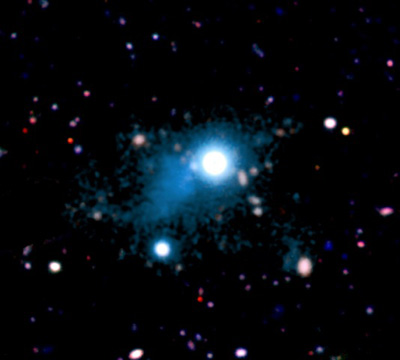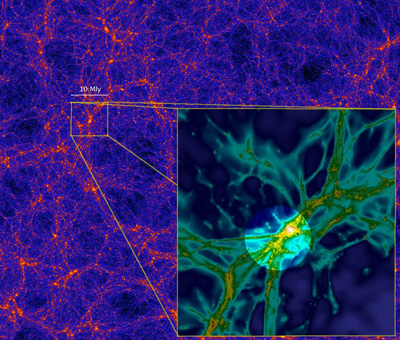Cosmic web imaged for the first time
January 20, 2014

This
deep image shows the nebula (cyan) extending across 2 million
light-years that was discovered around the bright quasar UM287 (at the
center of the nebula). The energetic radiation of the quasar makes the
surrounding intergalactic gas glow, revealing the morphology and
physical properties of a cosmic web filament. The image was obtained at
the W. M. Keck Observatory. (Credit: S. Cantalupo, UCSC)
Researchers at the University of California, Santa Cruz led the study, published January 19 in Nature.
Using the 10-meter Keck I Telescope at the W. M. Keck Observatory in Hawaii, the researchers detected a very large, luminous nebula of gas extending about 2 million light-years across intergalactic space.
“This is a very exceptional object: it’s huge, at least twice as large as any nebula detected before, and it extends well beyond the galactic environment of the quasar,” said first author Sebastiano Cantalupo, a postdoctoral fellow at UC Santa Cruz.
The cosmic web of matter

Computer
simulations suggest that matter in the universe is distributed in a
“cosmic web” of filaments, as seen in the image above from a large-scale
dark-matter simulation (the Bolshoi simulation, by Anatoly Klypin and
Joel Primack). The inset is a zoomed-in, high-resolution image of a
smaller part of the cosmic web, 10 million light-years across, from a
simulation that includes gas as well as dark matter (credit: S.
Cantalupo). The intense radiation from a quasar can, like a flashlight,
illuminate part of the surrounding cosmic web (highlighted in the image)
and make a filament of gas glow, as was observed in the case of quasar
UM287. (Credit: Anatoly Klypin, Joel Primack, S. Cantalupo)
This web is seen in the results from computer simulations of the evolution of structure in the universe, which show the distribution of dark matter on large scales, including the dark matter halos in which galaxies form and the cosmic web of filaments that connect them. Gravity causes ordinary matter to follow the distribution of dark matter, so filaments of diffuse, ionized gas are expected to trace a pattern similar to that seen in dark matter simulations.
Until now, however, these filaments have never been seen. Intergalactic gas has been detected by its absorption of light from bright background sources, but those results don’t reveal how the gas is distributed. In this study, the researchers detected the fluorescent glow of hydrogen gas resulting from its illumination by intense radiation from the quasar.
“This quasar is illuminating diffuse gas on scales well beyond any we’ve seen before, giving us the first picture of extended gas between galaxies. It provides a terrific insight into the overall structure of our universe,” said coauthor J. Xavier Prochaska, professor of astronomy and astrophysics at UC Santa Cruz.
The hydrogen gas illuminated by the quasar emits ultraviolet light known as Lyman alpha radiation. The distance to the quasar is so great (about 10 billion light-years) that the emitted light is “stretched” by the expansion of the universe from an invisible ultraviolet wavelength to a visible shade of violet by the time it reaches the Keck Telescope.
Knowing the distance to the quasar, the researchers calculated the wavelength for Lyman alpha radiation from that distance (based on the doppler frequency shift — similar to the decreasing pitch of a train whistle as it travels away from you) and built a special filter for the telescope’s LRIS spectrometer to get an image at that wavelength.
“We have studied other quasars this way without detecting such extended gas,” Cantalupo said. “The light from the quasar is like a flashlight beam, and in this case we were lucky that the flashlight is pointing toward the nebula and making the gas glow. We think this is part of a filament that may be even more extended than this, but we only see the part of the filament that is illuminated by the beamed emission from the quasar.”
Dark galaxies
A quasar is a type of active galactic nucleus that emits intense radiation powered by a supermassive black hole at the center of the galaxy. In an earlier survey of distant quasars using the same technique to look for glowing gas, Cantalupo and others detected “dark galaxies,” the densest knots of gas in the cosmic web. These dark galaxies are thought to be either too small or too young to have formed stars.
“The dark galaxies are much denser and smaller parts of the cosmic web. In this new image, we also see dark galaxies, in addition to the much more diffuse and extended nebula,” Cantalupo said. “Some of this gas will fall into galaxies, but most of it will remain diffuse and never form stars.”
The researchers estimated the amount of gas in the nebula to be at least ten times more than expected from the results of computer simulations. “We think there may be more gas contained in small dense clumps within the cosmic web than is seen in our models. These observations are challenging our understanding of intergalactic gas and giving us a new laboratory to test and refine our models,” Cantalupo said.
In addition to Cantalupo and Prochaska, the coauthors of the paper include Piero Madau, professor of astronomy and astrophysics at UC Santa Cruz, and Fabrizio Arrigoni-Battaia and Joseph Hennawi at the Max Planck Institute for Astronomy in Heidelberg, Germany.
This research was supported by grants from the National Science Foundation and NASA.
Abstract of Nature paper
Simulations of structure formation in the Universe predict that galaxies are embedded in a ‘cosmic web’1, where most baryons reside as rarefied and highly ionized gas. This material has been studied for decades in absorption against background sources, but the sparseness of these inherently one-dimensional probes preclude direct constraints on the three-dimensional morphology of the underlying web. Here we report observations of a cosmic web filament in Lyman-α emission, discovered during a survey for cosmic gas fluorescently illuminated by bright quasars at redshift z ≈ 2.3. With a linear projected size of approximately 460 physical kiloparsecs, the Lyman-α emission surrounding the radio-quiet quasar UM 287 extends well beyond the virial radius of any plausible associated dark-matter halo and therefore traces intergalactic gas. The estimated cold gas mass of the filament from the observed emission—about 1012.0 ± 0.5/C1/2 solar masses, where C is the gas clumping factor—is more than ten times larger than what is typically found in cosmological simulations, suggesting that a population of intergalactic gas clumps with subkiloparsec sizes may be missing in current numerical models.
References:
(¯`*• Global Source and/or more resources at http://goo.gl/zvSV7 │ www.Future-Observatory.blogspot.com and on LinkeIn Group's "Becoming Aware of the Futures" at http://goo.gl/8qKBbK │ @SciCzar │ Point of Contact: www.linkedin.com/in/AndresAgostini
 Washington
Washington